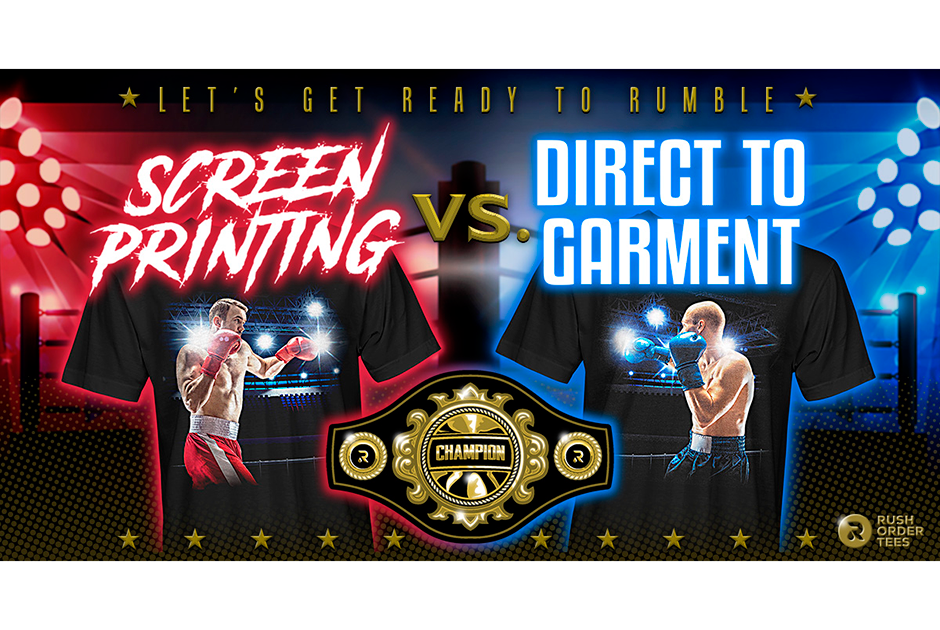Editor’s Note: This is the second in a three-part series exploring the differences between screen printing and direct-to-garment printing. This comparison is subjective, and any judgment indicated is a matter of the author’s preference.
Philadelphia-based Rush Order Tees decided to put decorating techniques to the test in an ultimate comparison between screen printing and direct-to-garment (DTG) printing. As digital printing has gained popularity and affordability in recent years, the company decided to take a look at the frequently asked question: How does DTG printing stack up against traditional screen printing?
In order to answer, both methods were compared in the form of a 10-round “fight.” Each round covered a different facet of custom apparel printing, including vibrancy, color matching, durability, and more.
Rounds 4-6 are reviewed below.
Round Four: Details
If an image is photographic or has gradients (fades, blends), screen printing will require halftones (tiny dots). Halftones were developed in the 1800’s and first used in newspapers to reproduce the tonal range of photographs, and soon became ubiquitous in screen printing. Most halftones for screen printing are output from a RIP program at anywhere from 30 LPI to 65 LPI (lines per inch) before being burned to screens. The lower the LPI, the bigger the dot.
Even at the higher LPI, these dots are visible if looked at closely. And if ink gain becomes a problem, each dot is going to spread out a little bit. Making it bigger and more visible.
DTG uses halftones as well, but these digital machines can print up to 1200 DPI and use diffusion dither. To get extra technical, this is a frequency modulated halftone instead of an amplitude modulated halftone. It can sometimes result in a grainy look, but a much better reproduction of small details.
Round Four pick: Direct-To-Garment
Round Five: Durability
Durability is something Direct-to-Garment has struggled with since the beginning.
In the early days of DTG, one would be lucky to get 10 washes out of a T-shirt before the colors would start fading. Today, consumers can get many, many washed out of DTG-treated shirts.
How many washes exactly?
Like most things in this business, it depends. The quality of the machine, the inks used to print, the pretreatment, the underbase, and the curing all factor into it.
It also will depend on how it is washed (stay away from hot water, harsh detergents, and long times in the dryer). So, yeah. Lots of things to be concerned about.
A well-done DTG print can potentially get dozens of washes before it starts fading a little bit. But fade it will, eventually.
Screen printing doesn’t have this durability problem if it’s done right. Sure, if the ink is not applied correctly or not cured properly, even Plastisol can start to fade or deteriorate. But we all have that shirt in our drawer from the family reunion 20 years ago that is still holding on. Longer than some marriages.
Round Five pick: Screen Printing
Round Six: Comfort & Feel
By Comfort & Feel, I mean a few things:
1. If the ink clogs up the fibers. This can severely reduce the breathability of the fabric, causing what is affectionately known as a “sweat patch”.
2. How heavy the print the feels on the shirt. If the ink is applied too thick, it can weigh down the front of the shirt, or wherever the print sits. This is especially important for all the lightweight blends that are so popular today.
3. If the texture is rough on the skin. Print shouldn’t feel like sandpaper, resulting in giving someone road rash from hugging them.
This feel is also known as “hand” in the screen-printing business. So, if the request is for “soft hand” it usually means to use discharge or water-based ink. If using Plastisol, it means to thin the ink down with an additive to make it smoother and more lightweight on the shirt.
Special note: Discharge and water-based inks will not work on all garment types and are considered specialty inks. For the purposes of this post, I’m comparing traditional Plastisol screen printing with DTG.
Screen printing techniques like “distress effect” can also create a softer hand by reducing the amount of surface area the ink occupies and breaking it up so it’s more flexible.
But adding this style is up to the customer and will not look right on all designs, so this saving grace only applies to particular orders.
Most regular screen-printing jobs will be printed with a normal layer of ink, and on dark garments it will be two layers of ink, counting the required underbase.
Plastisol screen-printing ink will typically tend to lay heavy on the shirt, and that’s one of the reasons why it’s so durable.
But when it comes to comfort and feel, DTG comes out on top.
Round Six pick: Direct-To-Garment
Imri Merritt has over ten years in the screen-printing industry and works for Rush Order Tees.





